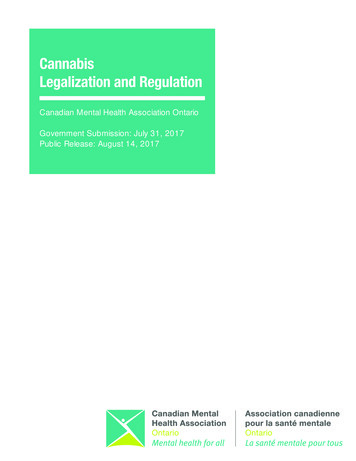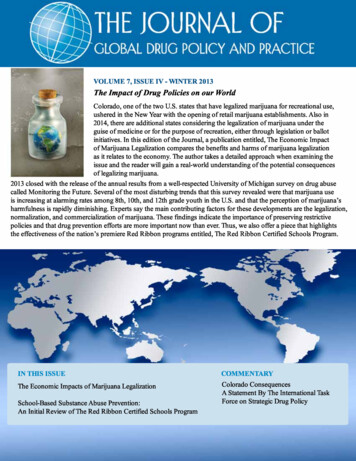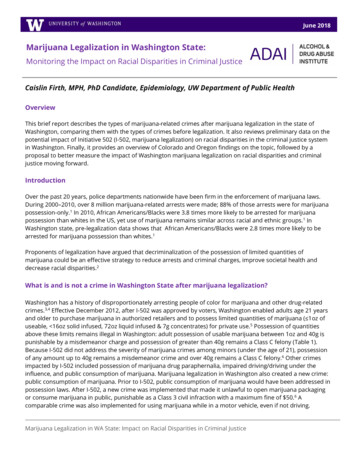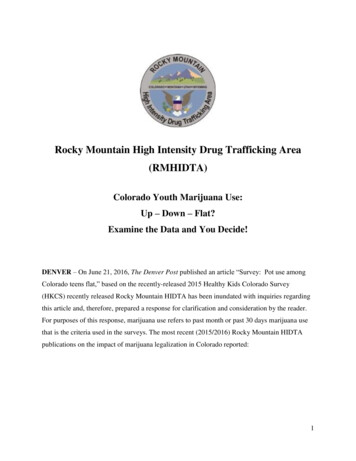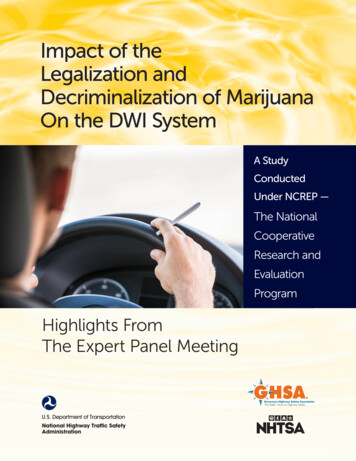
Transcription
Impact of theLegalization andDecriminalization of MarijuanaOn the DWI SystemA StudyConductedUnder NCREP —The NationalCooperativeResearch andEvaluationProgramHighlights FromThe Expert Panel Meeting
DisclaimerThis publication is distributed by the U.S. Department of Transportation,National Highway Traffic Safety Administration, in the interest ofinformation exchange. The opinions, findings, and conclusions expressed inthis publication are those of the authors and not necessarily those of theDepartment of Transportation or the National Highway Traffic SafetyAdministration. The United States Government assumes no liability for itscontent or use thereof. If trade or manufacturers’ names or products arementioned, it is because they are considered essential to the object of thepublication and should not be construed as an endorsement. The UnitedStates Government does not endorse products or manufacturers.Suggested APA Format Citation:National Highway Traffic Safety Administration, Governors Highway Safety Association, & theVolpe National Transportation Systems Center. (2017, June). Impact of the legalization anddecriminalization of marijuana on the DWI system: Highlights from the expert panelmeeting (Report No. DOT HS 812 430). Washington, DC: National Highway TrafficSafety Administration.
Technical Report Documentation Page2. Government Accession No.1. Report No.3. Recipient’s Catalog No.DOT HS 812 4304. Title and Subtitle5. Report DateImpact of the Legalization and Decriminalization of Marijuana on the DWI System:Highlights From the Expert Panel Meeting7. AuthorsJune 20176. Performing Organization Code8. Performing Organization Report No.National Highway Traffic Safety Administration, Governors Highway SafetyAssociation, and Volpe National Transportation Systems Center9. Performing Organization Name and Address10. Work Unit No. (TRAIS)National Highway Traffic Safety AdministrationOffice of Behavioral Safety Research, NPD-3101200 New Jersey Avenue SE.Washington, DC 2059011. Contract or Grant No.12. Sponsoring Agency Name and Address13. Type of Report and Period CoveredSame as above14. Sponsoring Agency Code15. Supplementary NotesHeidi Coleman from NHTSA, and Eve Rutyna, Kathy Blythe, Felicity Shanahan, and Jeffrey Bryan from Volpewere instrumental in developing of the project, planning the meeting logistics, and summarizing the meeting.Dereece Smither was the Project Manager.16. AbstractIn Moving Ahead for Progress in the 21st Century (MAP-21) Act, Congress directed NHTSA to establish acooperative program—the National Cooperative Research and Evaluation Program (NCREP)—to conduct researchand evaluations of State highway safety countermeasures. NCREP was continued in the Fixing America’s SurfaceTransportation Act. This program is administered by NHTSA, and managed jointly by NHTSA and GHSA. Eachyear, the States (through GHSA) identify potential highway safety research or evaluation topics they believe areimportant for informing State policy, planning, and programmatic activities.One such topic identified by GHSA, the legalization and decriminalization of marijuana, forms the basis for thisproject. States need information about the impacts of laws that legalize or decriminalize the use of marijuana,including its impact on driving safety and the State’s driving while impaired (DWI) system. NHTSA and GHSAconvened one-and-a-half day expert panel of professionals involved in and impacted by the enactment ofrecreational and/or medical marijuana laws. Participants represented States that had enacted such laws (e.g.,Washington, Colorado, Oregon, California) and fields of practice that are engaged in the DWI system, includinglaw enforcement, prosecutors, judges, probation, toxicologists, and highway safety officials. The objectives of theexpert panel included (a) identifying changes to the DWI system following enactment of laws legalizing and/ordecriminalizing marijuana for medical and/or recreational purposes; (b) identifying lessons learned by these States;and (c) identifying measures that should be used to evaluate the effects of enacting recreational and/or medicalmarijuana laws, and their impact on traffic safety and the DWI system, using both quantitative and qualitativemethods. Convening the expert panel was Phase I of a two-phase project to determine the impacts of lawslegalizing or decriminalizing marijuana. Phase II will be a project to collect the data based on the recommendationsof the panelists. Details about the meeting logistics, the panelists, and their discussions and recommendations aresummarized in this report.17. Key Words18. Distribution StatementExpert panel; Marijuana; THC; Drugs; Driving; States;DWI system; Research; Behavioral Safety; QualitativeResearch; Quantitative Research; Research Methods;Measuring Change; Highway SafetyDocument is available to the public viaNational Technical Information Service, www.ntis.gov;the NHTSA website, www.nhtsa.gov; andat the Behavioral Safety Research Reports dex.shtm19. Security Classif. (of this report)20. Security Classif. (on this page)21. No. of PagesUnclassifiedUnclassified22. Price30Form DOT F 1700.7 (8-72)i
2015 NHTSA Expert Panel on Legalization/Decriminalization of Marijuana on DWI – HighlightsBackgroundThe legalization and decriminalization of marijuana has received a great deal of media attentionacross the country, and many States are considering whether they should legalize marijuana forrecreational or medical use. States need information about the impacts of laws that legalize ordecriminalize the use of marijuana, including its impact on driving safety and the State’s drivingwhile impaired (DWI) system.A total of 25 States, the District of Columbia, and Guam allow marijuana and cannabis programsfor medical use. Recently approved efforts in 17 States allow use of “low THC, high cannabidiol(CBD)” products for medical reasons in limited situations or as a legal defense (NationalConference of State Legislatures, 2016). Four States and the District of Columbia have legalizedmarijuana for recreational use. Nine States have ballot measures for recreational or legalmarijuana and four States were either gathering ballot signatures or certifying initiatives(Underhill & Umodo, 2016).During its most recent survey, the 2013-2014 National Roadside Survey (NRS) of Alcohol andDrug Use by Drivers, the National Highway Traffic Safety Administration (NHTSA) collectedbreath, oral fluid, and blood samples to detect alcohol and drug use by weekday daytime andweekend nighttime drivers, from a nationally representative sample (Berning, Compton, &Wochinger, 2015). Nearly one in four drivers tested positive for at least one drug that could affectsafety (22.4% of daytime weekday drivers and 22.5% of weekend nighttime drivers). In 2007,some 16.3 percent of weekend nighttime drivers tested positive for drugs based on the combinedresults of oral fluid and blood tests (Compton & Berning, 2009). In 2013-2014, the percentage ofweekend nighttime drivers who tested positive for drugs (using the same criteria that had beenused in 2007) had increased to 20 percent. The percentage of drivers with marijuana in theirsystem increased by nearly 50 percent (from 8.6% in 2007 to 12.6% in 2013-2014).A second NHTSA study, the 2015 Drug and Alcohol Crash Risk Study, initially seemed to find astatistically significant increase in unadjusted crash risk for drivers who tested positive for use ofillegal drugs (1.21 times), and THC (1.25 times). However, when the crash risk analysis wasadjusted for other well-known risk factors, such as age, gender, race, and ethnicity, there was nolonger a statistically significant difference in crash risk associated with the presence of thesedrugs. This finding indicates that these other variables (age, gender, race, and ethnicity)accounted for the detected increase in risk. This may be due, at least in part, to the fact that youngmales are more likely to test positive for illegal drugs and marijuana, and they are also morelikely to be involved in crashes (Compton & Berning, 2015). Alcohol use was highly correlatedwith increased crash risk, even after adjusting for other known risk factors.The Impact of the Legalization and Decriminalization of Marijuana on the DWI System projectexamines how the legalization and decriminalization of marijuana impacts a State’s DWI system.It will focus on the impacts following enactment of recreational and/or medical marijuana laws onvarious aspects of the State’s DWI system, including enforcement, prosecution, adjudication,probation, toxicology, communication, and highway safety operations. Lawmakers, State andlocal governments, the Governor’s Highway Safety Association (GHSA), State Highway SafetyOffices, NHTSA, and other Federal agencies, will be the primary audience.During Phase I of the project, NHTSA and GHSA convened an expert panel of professionalsinvolved in and impacted by the enactment of recreational and/or medical marijuana laws.Participants represented States that had enacted such laws (e.g., Washington, Colorado, Oregon,California) and fields of practice that are engaged in the DWI system, including law enforcement,prosecutors, judges, probation, toxicologists, and highway safety officials.1
2015 NHTSA Expert Panel on Legalization/Decriminalization of Marijuana on DWI – HighlightsObjectiveThe objectives of the expert panel included: Identifying changes to the DWI system following enactment of laws legalizing and/ordecriminalizing marijuana for medical and/or recreational purposes, including positive,negative and unintended changesIdentifying lessons learned by these States, including:o In hindsight, things that these States would have done differentlyo Things that other States (that are currently contemplating changes to their laws)should considerIdentifying measures that should be used to evaluate the effects of enacting recreationaland/or medical marijuana laws, and their impact on traffic safety and the DWI system,using both quantitative and qualitative methods.ParticipantsGHSA and NHTSA selected panelists from States that had enacted laws that legalized and/ordecriminalized marijuana for medicinal and/or recreational use, and who represented professionsinvolved in the DWI system, including law enforcement, prosecution, adjudication, probation,treatment, toxicology, highway safety, communications, and data management. The VolpeNational Transportation Systems Center (Volpe Center) provided logistical support in planningand facilitating the expert panel. The invitation letter that was used to invite participants isincluded as Appendix A. Refer to Appendix B: Meeting Attendees for a complete list ofattendees.NCREPNHTSA’s mission is to save lives, prevent injuries, and reduce economic costs due to trafficcrashes, through education, research, safety standards, and enforcement activity. In the MovingAhead for Progress in the 21st Century (MAP-21) Act, Congress directed NHTSA to establish acooperative program—the National Cooperative Research and Evaluation Program (NCREP)—toconduct research and evaluations of State highway safety countermeasures. NCREP wascontinued in the Fixing America’s Surface Transportation (FAST) Act. This annual 2.5 millionprogram is administered by NHTSA, and managed jointly by NHTSA and GHSA. Each year, theStates (through GHSA) identify potential highway safety research or evaluation topics theybelieve are important for informing State policy, planning, and programmatic activities. One suchtopic identified by GHSA forms the basis for this project, reflecting the high level of interest bythe States.AgendaThe one-and-a-half-day meeting began with welcoming remarks from Jeff Michael (Director,NHTSA Office of Research and Program Development) and Jonathan Adkins (GHSA ExecutiveDirector).The expert panel focused on seven areas: law enforcement; prosecution; adjudication, the courtsystem and treatment; forensic laboratories; data; state highway safety offices; and publicoutreach and communication.During the first day of the meeting, subject matter experts discussed the following questionsregarding each of the focus areas:oooWhat changed with the new laws? What really worked and what didn’t work?Knowing what you know now, what would you have done differently?What are you planning to do in the future?2
2015 NHTSA Expert Panel on Legalization/Decriminalization of Marijuana on DWI – HighlightsDuring the second day, subject matter experts were asked to suggest measurements to evaluatethe effects of legalizing or decriminalizing marijuana, and to discuss next steps and State needs.The full agenda used for the meeting is contained in Appendix C. This report contains highlightsfrom the day-and-a-half meeting, based on the discussions that took place.Meeting HighlightsThe following table summarizes selected points made by expert panelists during the round tablediscussions. These points offer insights into the DWI systems in the States that participated in themeeting, at the time that the meeting was held. For more details about State marijuana laws, referto Appendix D: Status of State Marijuana Laws in Expert Panel States. Appendix E containsdetails regarding drugged driving per se laws. The DWI systems are discussed at greater length inthe Discussion Topics section below.State SnapshotsStateSelected Points from Participating StatesArizonaLab reports take an average of 6 to 8 months to be provided and up to a year in some cases.Often, cases are dismissed or there are plea bargains.A court overturned the 5 nanogram (ng) level, stating there is no scientific evidence that itcauses impairment.Good police work, careful and detailed observations and notes, corroborated with toxicology testresults, help make the case in court.CaliforniaLaw enforcement grants are available. The focus is on enforcing the medical marijuana law.During the first year of a grant, Orange County doubled the number of drug recognition experts(DREs). Each agency now has one certified DRE. DRE classes are held each month.Blood samples are the best evidence. Oral fluid does not detect certain drugs.The State hires contract phlebotomists under the public health code, providing a one-hourturnaround. A fee is levied against the individual for the blood draw.There are 10 public and 20 private crime labs. It takes 12 to 18 months to validate methods fortesting new drugs.Eight prosecutors handle DWI cases and educate district attorneys. Orange County has a 98percent conviction rate and convicts with less than 3 ng. Warrants have a fast turnaround using aone page McNeely warrant. Cases are sent to court quickly.ColoradoThere are many unanticipated expenses in connection with a new law. For example, the budgetfor DRE and ARIDE increased from 50,000 to 500,000.There is also a new revenue stream from the new marijuana industry. There is potentially a greatdeal of money available, but you need to anticipate and document your needs and ask for a shareof the funds.A representative of the marijuana industry has participated in State task force meetings andserved as a resource for funding for public education.In 2009, there were 38,000 medical marijuana cards issued; in 2015, there were 116,000. Thenumber of cards has increased, especially in areas where there are no recreational distributors.Holders of medical marijuana cards can receive two ounces of marijuana; others can receive justone ounce.The State did public outreach early, including on the topic of driving while impaired bymarijuana.State surveys found that people are more likely to smoke and drive than drink and drive, andyoung people drank more alcohol and used more marijuana.3
2015 NHTSA Expert Panel on Legalization/Decriminalization of Marijuana on DWI – HighlightsStateSelected Points from Participating StatesMontanaThe State has DWI courts and regular courts.The type of treatment used is matched to each treatment group. There is a wide age range andoutcomes are good.DWI courts in the State are participating in a study. Data is reported weekly. Seven out of 74who received treatment were re-arrested, while 89 percent of the comparison group recidivated.OregonOregon was the first State to legalize marijuana for medical purposes.VermontThe State pays an outside lab 250 per test and a 10,000 fee for forensic testimony for eachcase. Courts have a backlog of 250 DWI cases. There is only one DWI court.WashingtonThe three markets of illicit (untaxed/unregulated), medicinal and recreational marijuanacurrently are estimated to generate 1.2 million in sales daily. Recreational marijuana generated 75 million in tax revenue last year.The recreational marijuana law rules were modeled after the liquor regulations in the State.The State is now developing an electronic warrant system and judges will have tablets to issue awarrant. Spokane has achieved a 13-minute turnaround time.Public education can lead to behavior change and changes to the social norm.4
2015 NHTSA Expert Panel on Legalization/Decriminalization of Marijuana on DWI – HighlightsDiscussion TopicsIn GeneralThe legalized sale of marijuana is a new industry. When States enact laws legalizing marijuana,highway safety is typically not a primary focus. However, these law changes lead to manyimpacts on the DWI system and unanticipated costs, such as increases in law enforcement,prosecution, court resources, toxicology lab tests, and testimony.Colorado and Washington State, the first two States to legalize sales ofmarijuana for recreational use, have generated tax revenue. However, therehave been fewer funds available to support the DWI system than originallyanticipated. It is important to anticipate and estimate these costs ahead oftime, and seek to take advantage of the new funding stream by requestingresources to address anticipated increased needs.States shouldanticipate increasedcosts and requestresources from newfunding streams.Law EnforcementIn jurisdictions where marijuana is illegal, law enforcement officers who detect drivers withmarijuana are likely to focus primarily on a “possession of marijuana” charge. When marijuanabecomes a legal substance, law enforcement must change its mindset, and focus instead onwhether the suspect was driving while impaired by marijuana. These enforcement efforts requiretraining for professionals and should be supported by public education, emphasizing the risks ofdriving while impaired by marijuana and enforcement efforts to prevent it.Revenue from marijuana legalization provides an opportunity forincreased training and staffing. Law enforcement training to helpOfficers should change theirofficers properly identify impaired drivers is essential, especiallymindset from possession oftraining in Standardized Field Sobriety Testing (SFST), Advancedmarijuana to driving whileRoadside Impaired Driving Enforcement (ARIDE), and Drugimpaired by marijuana.Evaluation and Classification (DEC). Training for the arrestingOfficers also should focusofficer should include recognizing the signs and symptoms of drugson signs of impairment, not(including marijuana), since most officers have much moreon the level of THC.experience with alcohol than with drugs. Mock trials are usefulelements of the training. They help to illustrate for officers theissues that are likely to arise in court. When developing anddelivering training, law enforcement should take advantage of experienced prosecutors and trafficsafety resource prosecutors (TSRPs). Police officers should also receive training on report writingand how to testify in court. The arresting officer is typically the most critical witness in a case.During an arrest, officers need to focus on signs of impairment, not on the level of THC. Theymust take good, detailed notes, based on their observations. The toxicology test can be used tocorroborate their findings.The trend in drug testing is moving away from urine and toward blood. There is interest in usingoral fluid devices for some drugs (e.g., THC). The possible use of breath testing devices is alsobeing explored.The U.S. Supreme Court has ruled (in Missouri v. McNeely, 2013) that warrants are needed inmost cases before drawing a blood sample. In some jurisdictions (e.g., Orange County,California), this is not difficult to do. In some jurisdictions (e.g., Arizona, Texas, and Utah), if asuspect refuses to provide a blood sample, a phlebotomist can be brought in, once a warrant hasbeen obtained. However, blood draws are not permitted without the consent of the suspect inother States (e.g., Vermont and Washington). Phlebotomists can be hired on a contract basis.5
2015 NHTSA Expert Panel on Legalization/Decriminalization of Marijuana on DWI – Highlights(This is being done in California.) Regardless of the process, every effort should be made toreduce the amount of time between stop, arrest, acquiring a warrant and the blood draw.Officers should be able to find out whether a suspect has a medical marijuana card. Healthinformation is protected through the Health Insurance Portability and Accountability Act(HIPAA), but there are exceptions for disclosure for law enforcement purposes. A medicalmarijuana card offers a defense for a suspect in possession of marijuana in a“medical marijuana” State. It is not a defense, however, to driving whileProsecutors shouldimpaired by marijuana.Marijuana laws can be modeled on liquor laws (e.g., Washington State). It ishelpful to develop new legislation in partnership with a broad range ofstakeholders, such as industry representatives, health professionals, lawenforcement, prosecutors, and court officials.receive training onwhich questions toask.–ToxicologistProsecutionSome State statutes have a “per se” limit of 5 ng (e.g., Colorado). Representatives at the meeting(including from Colorado) consider that level to be “too high.” According to participants at themeeting (including toxicologists), the science does not support a per se level, due (at least in part)to the manner in which marijuana is processed in the human body. If not hampered by legalstatutes, prosecutors in some jurisdictions go to trial and successfully obtain convictions withlevels as low as 2 ng (California).Cases should be brought to trial based on “the totality of the circumstances.” Vermont’s statutemakes it illegal to drive “while impaired to the slightest degree.”Marijuana prosecution takes more time and effort compared to other litigation. Good preparationand report writing by the arresting officer go a long way toward supporting a conviction.Training and education (for prosecutors, law enforcement, and others) is critical to mountsuccessful cases against defense arguments about marijuana and drug-impaired driving. Manyprosecutors assigned to DWI and DUID (driving under the influence of drugs, e.g., THC, and notalcohol) are inexperienced. They are also overworked, with backlogs and not much time forpreparation. Drug-impaired driving cases are challenging. Jurisdictions should insist on usingexperienced prosecutors (whenever possible). This is a condition of grant funds in California. Ifprosecutors are not experienced, they should rely on TSRPs, whose role is to provide support andserve as a liaison for front line prosecutors. The National Traffic LawCenter (NTLC) is another resource for prosecutors. They offer trainingMarijuana prosecutioncoursesin drug-impaired driving, including “Prosecuting the Druggedtakes more time andDriver.” Prosecutors should attend DRE classes and mock trials when theyeffort compared toare starting out in this field. Once they gain experience, they shouldother litigation.support and assist law enforcement officials in delivering ARIDE andDRE training.Jurors may be sympathetic to offenders. They too should be educated about drug-impaireddriving.When trying cases, prosecutors should charge separately for alcohol anddrugs, if their statute allows this. If not, the statute should be changed.Offenders should not be permitted to plead to a charge of reckless driving.Prosecutors should work closely with law enforcement and toxicologylaboratories, and must ask toxicologists the “right questions” to elicit thefacts that are needed to establish the foundation for each case. It is importantfor prosecutors to understand that testing positive for THC does notnecessarily indicate that a suspect was impaired.6“Judges don’t wantto ask questions, butthey want to know.”– Judge
2015 NHTSA Expert Panel on Legalization/Decriminalization of Marijuana on DWI – HighlightsCourt Administration, Adjudication, Treatment, Probation, and ParoleTraining and education are critically important. Judges should be educated separately (privately),so they can ask questions in a safe environment (without appearing uninformed). According to ajudge serving on the expert panel, “Judges don’t want to ask questions, but they want to know.”“Wet labs” (where judges can observe subjects who have been dosed with marijuana), DREcards, State-specific bench books, and other compilations of facts are very helpful to judges.Prosecutors can provide notices about recent changes to the law (e.g., new statutes, statutoryamendments, or case law) to all judges (who hear these types of cases), through a judicialeducator, or by filing pretrial motions containing the latest information.While judges are presiding over cases, a reliable assessment of the offender is very important toensure that appropriate treatment can be ordered as part of sentencing. Cases often involve a“battle of experts.” Judges need to be educated so they can weigh competing testimonyknowledgably.Probation tends to be light, or even not available, for most offenses, since many impaired drivingcharges are not felonies (or even misdemeanors), especially on a first or second offense.However, immediacy of response is important. According to participants at the meeting, at least60 percent of DUI/DUID offenders do not recidivate. However, the challenge is being able topredict which 40 percent is at risk of reoffending. This provides another reason why a reliableassessment is needed.There is a great deal of support for DWI courts, but it is an expensive option, and it’s notappropriate for all offenders. DWI court is designed for serious offenders with alcohol and/ordrug dependence issues. It is likely to be counterproductive for offenders who do not need thatlevel of supervision. A hard suspension can be a barrier to DWI court, since offenders may havedifficulty traveling to the court and meeting their other obligations if they are unable to drive.Members of the expert panel asked whether DUID offenders should attend DWI court or Drugcourt, since DWI courts are designed for DWI offenders and focus primarily on alcohol. For bestpractices, see the National Center for DWI Courts online at www.dwicourts.org/.Some laws require the use of ignition interlocks (which test only for alcohol)even if the offender was only DUID.If individuals have a medical marijuana card and are on probation, this is nolonger a violation of probation unless this is addressed individually and upfront,by the court. Judges should make sure to address this issue.Toxicology is acritical part of thecriminal justicesystem.ToxicologyToxicology is the scientific study of chemicals, drugs, and other substances, and how a person orother living thing reacts to them. Toxicology plays a critical part in the criminal justice system,especially in drug-impaired driving cases. According to a toxicologist who served on the expertpanel, “Toxicologists rely on research and, unfortunately, there currently isn’t much.”Accordingly, many cases involve competing testimony about toxicology, “expert versus expert.”Laboratories desperatelyneed more equipment andmore staff to run tests andprovide testimonies.– ToxicologistChronic users (e.g., people using marijuana for medicinal purposes)can have high levels of marijuana present in their bodies, but theymay not be impaired. Data is often misused. For example, carboxy (ametabolite of THC) is “inactive” but its presence may (incorrectly) beused to “show” impairment. Some drugs (e.g., prescriptionmedications) can improve driving, while other prescription medicines,even if used as directed, can have serious impairing effects.7
2015 NHTSA Expert Panel on Legalization/Decriminalization of Marijuana on DWI – HighlightsToxicology laboratories are grossly underfunded. The workload is high, and it’s hard to keep up.However, it is important to invest in technology to provide labs with the capacity to handleincreased demands.Laboratories desperately need more equipment and more staff to run tests and provide testimony.In Washington State, the number of tests each year increased from 4,500 positive tests to 6,000positive tests by lowering the “cut-off” (the threshold for being considered positive). InCalifornia, only 25 percent of offenders are tested for THC.Tests are expensive. Laboratories cannot test all offenders for all drugs. According to a prosecutoron the expert panel, “It often comes down to the money.” California tests only for THC,methamphetamine, and barbiturates. In Vermont, a lack of resources has caused long delays(months) in impaired driving cases.Delays in drawing samples can cause counts to drop, which makes it less likely that the resultswill be positive. Likewise, delays in testing a sample can lead to a similar result, making it harderto detect drugs. Providing testimony represents an enormous demand of time on laboratory staff.Washington State reported that testimony was required for 4,000 DUI cases in a single year.Laboratories across the country (or even within a State) follow very different practices, such aswhich drugs to test and which thresholds to use as cut offs. Standardization is needed to allowstatewide or national comparisons and to fill in gaps in data. Consistency in reporting shouldaddress not only
decriminalizing marijuana for medical and/or recreational purposes; (b) identifying lessons learned by these States; and (c) identifying measures that should be used to evaluate the effects of enacting recreational and/or medical marijuana laws, and their impact on traffic safety and the DWI system, using both quantitative and qualitative methods.



